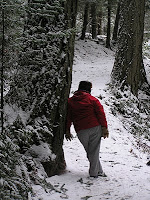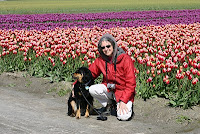Rocks are definitely older. Geologic processes have been happening on our planet for 4.7 billion years – and in our part of the world for a few hundred million years – at very slow rates.
The second most active volcano in Washington, Mt. Baker is less than one million years old.
The hills on which our house perches were formed by the pressure of a shoving match between tectonic plates, as well as the Holocene glaciations from the last Ice Age, which covered Whatcom County in 5,500 feet of ice and ended 10,000 years ago.
The Douglas fir trees which give us precious shade and habitat for the birds in our yard are probably 80 to 100 years old, but could live to be 600 years or more.
The orange and black Varied Thrushes who showed up at our bird feeders in the extreme cold last week are so elusive that no one knows how long they live, but the educated guess is five years. Two of them froze to death and fell onto our side patio during the night.
The orange and black Varied Thrushes who showed up at our bird feeders in the extreme cold last week are so elusive that no one knows how long they live, but the educated guess is five years. Two of them froze to death and fell onto our side patio during the night.
People who are younger than I am:
 • The kids in the neighborhood who were playing in the snow Thanksgiving morning and let me play too.
• The kids in the neighborhood who were playing in the snow Thanksgiving morning and let me play too. • In some cases, their grandparents.
• Everyone I work with.
• Some of their parents.
• Some people who have died already.
Older than I am:
• Lynne.
• Many of our friends, like Bonnie.
• Ken and Phyllis, our neighbors down the street who are in their mid 70s and active and healthy.
• Lynne’s brother, Richard. He is 73, still works full time. He and Viv, his wife went for a good hike with us on Mt. Baker when they visited in the fall.
• Grace and Allen, our good friends from Lexington, who encouraged us to buy our first popup camper, and who are still camping in a popup camper in their early seventies. Allen is still teaching full time.
• My older siblings, Martha, Kit, Doug and Thom, who are 68, 64, 63 and 61 respectively. They are all doing well.
• My mother, who is 94 1/3. Ice cream is a mainstay in her nutritional plan.
I don’t know how much time I have left--one minute or 50 years, but I do think about it.
I suggested to Lynne that we set some goals for our next 20 years. Goals? she said. What for?
So I took a different approach. What do I hope for in the next 40 years?
• That Lynne and I live out our lives together.
• That we live in a peaceful and safe neighborhood.
• That Winnie stays with us for as long as her tail wags.
• That we build and sustain connections with friends and family.
• That our savings and pensions sustain us free of financial insecurity.
• That we express ourselves artistically.
• That we are good stewards of the earth’s environment.
Then I thought some more. Here is the rest of the list:
• That you live out your life with those whom you love.
• That neighborhoods worldwide are peaceful and safe.
• That whatever makes your heart swell stays with you a long long time.
• That you build and sustain connections with friends and family.
• That you are free of financial insecurity.
• That you express yourself, artistically or otherwise.
• That all of us are good stewards of the earth’s environment.
How old are you? What do you hope for?





























